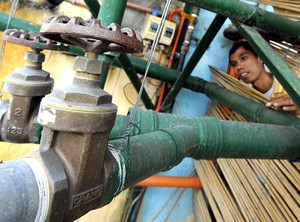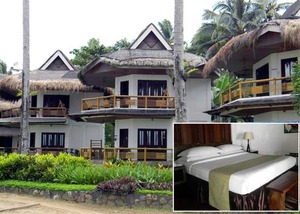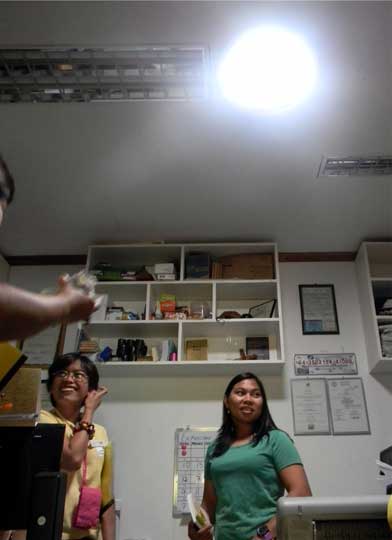A green movement is taking place in Philippine's hospitality sector, with a few resorts like Daluyon Beach and Mountain Resort and Puerto Pension taking lead. This is partly due to Zero Carbon Resort initiative. Text and Photos by Henrylito D. Tacio
Davao City, 20 Nov 2011. Global warming, an environmental threat unlike any the world has faced, is thought to be caused by an increase in the amount of greenhouse gases spewed into the atmosphere chiefly through human activities. Greenhouse gases refer to carbon dioxide, methane and other industrial gases.

Daluyon Beach and Mountain Resort made design and material changes to save energy and water with Zero Carbon Resort guidelines
Scientists say carbon dioxide, the primary culprit, makes up only .035 percent of the atmosphere (excluding moisture) but plays a vital role in life on this planet. Green plants absorb carbon dioxide during photosynthesis, and both plants and animals produce it as end product of respiration.
“Like panels of glass in a greenhouse,” writes Noel Grove in an article that appeared in National Geographic, “carbon dioxide allows most solar radiation to penetrate the atmosphere but prevents part of the heat radiated by land and bodies of water from escaping into space. As carbon dioxide accumulates, enough heat may be trapped to gradually warm the atmosphere.”
In the past 200 years, the amount of carbon dioxide in the atmosphere has increased by 30 percent, according to the Nobel Prize-winning Inter-governmental Panel on Climate Change.
“Roughly three-quarters of the added carbon dioxide in the atmosphere has come from burning fossil fuels such as coal and oil, and roughly a quarter from the destruction of tropical rainforests,” says the London-based Panos Institute.
Among the impacts of climate change as a result of global warming are excessive rainfall, flooding, sea level rise, and extreme temperature. The tourism industry will bear the brunt of these consequences, according to Elisea Gozun, the presidential assistant on climate change.

Puerto Pension's piping improvements and meter installation led it to save precious water
In a forum held recently in Davao City during the culminating activity of Davao Gulf Week, Gozun warned local governments, particularly those situated in coastal areas, to be prepared of the implications of gradual rise of seawater levels that “will eventually reduce the area of our wetlands and other low-lying areas.”
“The ocean will devour our lands,” the former environment secretary warned. “They will be under the water. This phenomenon has a great impact on tourism since bulk of our tourism attraction is located in coastal areas.”
This is the reason why government officials are urging resorts and hotels to do something to lessen the emissions of carbon dioxide and other greenhouse gases into the atmosphere. And they can help by going green.
“Going green is an enormous challenge for the tourism industry,” Puerto Princesa tourism officer Rebecca Labit told members of the Philippine Network of Environmental Journalists (PNEJ) who visited Palawan’s capital recently. “We have been encouraging hotels and resorts to introduce measures designed to lessen the impact of their operations and practices on the environment.”
And Palawan is seeing positive results. This is due to a project called Zero Carbon Resorts (ZCR), which triggers a switch from fossil fuel to the use of renewable energy sources at the small and medium companies in the tourism industry such as hotels, resorts and restaurants.

Comfort at Daluyon Resort without costing the environment
The three remaining objects are to reduce emissions and pollution in urban and remote, environmentally sensitive areas; to decrease dependence on fossil fuels thus slowing down climate change; and to increase availability of energy services in urban and remote areas.
The ZCR project targets more than 500 hotels and resorts in the Philippines. Currently, most ZCR members are from Puerto Princesa and some resorts in El Nido. It has also been introduced in some major tourist destinations such as in Banaue, Bohol and Cagayan de Oro. Davao and Samal have yet to follow suit
In Puerto Princesa, Daluyon Beach and Mountain Resort has led other local resorts in the mission of bringing environment consciousness to the forefront. Located in barangay Cabayugan some 80 kilometers northwest of Puerto Princesa in the white-sand beaches of sitio Sabang, it is near the two famous tour sites of Puerto Princesa: the Puerto Princesa Subterranean River National Park and Sabang Mangrove Forest. Both are located 20 minutes from Daluyon.
Daluyon has 8 modern-Asian beach villas (two rooms per villa), a conference pavilion which can accommodate 150 people, and a swimming pool. A restaurant and bars are also available.

Ruben Tan: It is good business sense to run a responsible commercial outfit that cares for the environment
The rooms are equipped with an air-conditioner and ceiling fan, solar hot water, mini-bars, and other multimedia elements such as wi-fi, satellite cable TV, and DVD player. Although Sabang is still without electricity, the resort provides 24-hour generated power.
“Every month, we used an average of 5,000 liters of fuel,” said Ruben “Butch” F. Tan, Jr. the resort’s chairman and chief executive officer. “So, we have to look for economical ways of saving on energy and water.”
Daluyon was opened to the public in 2007 but it was not until two years later that it became a member of ZCR. “By implementing energy-saving measures, using water-saving equipment and other environment-friendly techniques, we were able to save money,” Tan said.
Tan followed the 3Rs recommended by the ZCR project: reduce energy consumption, replace inefficient appliances and equipment, and redesign buildings into more self-sufficient, carbon-neutral structures.
For Daluyon, the peak-load management use of electricity is being applied. Electricity for resort purposes are utilized during hours when guests are out – usually during tour periods so energy is used sparingly without compromising guest comfort.

Solar tube lightings on ceilings allow natural light to stream through
For another, the resort adopted the solar hot water supply system. By installing water meters, the resort has now better understanding of its water consumption used per area.
Tan also installed louver ventilation at the generator power house and staff house to help cool the generators and let natural air to circulate. The roof ventilation also allows natural light to come in so there’s no need to turn on electric light during daytime.
The luxurious villas also make use of window slats to allow natural light and air to flow. Instead of using the aircon all the time, guests are enticed to open doors and windows at their individual balconies to enjoy the view of the beach and cool air from the mountains.
In its kitchen and restaurant, tubular lightings are installed. “As a result, we now switched off our fluorescent lamps during the day,” Tan claimed. “Our kitchen personnel also observed that it is now a bit cooler inside the kitchen because of less heat that was gained from the fluorescent lamps during daytime in the past.”
Waterless urinals at public comfort room contribute to the efforts of reducing water consumption at minimum level. “We save approximately 150,000 liters of water per urinal,” Tan said.
Low-cost water sprinkler and insulation at the roof of the function tent were installed to cool the area. There is no need to install more air-conditioned units, thus reducing the resort’s overall energy consumption.

Electric blue swimming pool with safety and hygiene features
Perhaps the favourite among family visitors is the electric blue swimming pool constructed using Quartzon. The material keeps temperature tepid – even during cooler months. The pool makes use of salt chlorinator as pool filter which has less ammonia and other harmful chemicals. Because of this, it is actually safe to swim even during cleaning time.
Daluyon is an environment-friendly resort at its best. Local materials were used for the main structures such as the villas, the restaurant, and the lounge area. Cogon was generously used for rooftops, while recycled wood from both the sea and the forest were utilized for the wood panels, as well as some of the furniture such as tables, benches for the rooms, and even the front office desk.
In the heart of Puerto Princesa, Puerto Pension Bed and Breakfast is also adopting the zero carbon concepts. Still owned by Tan, it started its operation in 1993. “We have been implementing practical ways to conserve energy and improve its efficiency by doing the measures that have been suggested by the ZCR project,” Tan said.
Among Puerto Pension’s mitigation measures involve rain water collection and filtration for bathroom use, installation of solar tubes, simple natural lighting techniques and ventilation, water consumption monitoring, installation of power on delay in the admin office and door springs in the bathroom doors.
“These implemented measures led to a remarkable reduction – about 40% of the running costs – in electricity and water consumption,” Tan pointed out.
Daluyon Beach and Mountain Resort and Puerto Pension are becoming popular among tourists because of what both are doing in helping save the environment. And it’s only a matter of time that other resorts and hotel will be following suit.
“I think everybody is going in that direction and awareness of environmental issues is growing,” Tan told the visiting environmental journalists. “For our part, we just keep on upgrading and re-inventing in a greener way as there are green technologies we can choose from. Being a responsible businessman and simultaneously caring for the environment is good business sense.”
Useful Links:
Asia Society for Social Improvement and Sustainable Transformation
Palawan Council for Sustainable Development
Philippine Green Building Council
PATH Foundation Philippines